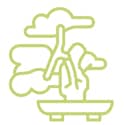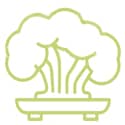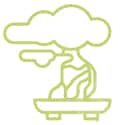
Bonsai artists look at what nature creates and work to emulate it when shaping a tree, but they also add their own vision to produce a beautiful bonsai. That’s why a bonsai is so much more than just a tree in a container. Bonsai styles can be grouped in many ways. Forms derive their names from the tree’s angle of growth from a container and provide a common starting point for exploring styles. Below are just a few examples of the styles.
STYLES OF BONSAI

FORMAL UPRIGHT (Chokkan)
The tree has a straight, upright, tapering trunk. Branches progress regularly from the thickest and broadest at the bottom to the finest and shortest at the top. This gives the branches a triangular shape and symmetry which is sought after for a formal upright style. There should be strong surface roots visible, moving from the base of the trunk downward into the soil, and radiating evenly around the trunk

INFORMAL UPRIGHT (Moyogi)
The trunk and branches incorporate visible curves, but the apex, or tip, of the tree is located directly above the trunk’s entry into the soil line. Similar to the formal upright style, branches progress regularly from largest at the bottom to smallest at the top, although this progression may be broken where the irregular shape of the trunk would make a branch abnormally prominent or obscure.

BROOM (Hokidachi)
This style is employed for trees with extensive, fine branching, often with species like elms. The trunk is straight and upright. It branches out in all directions about ⅓ of the way up the entire height of the tree. The branches and leaves form a ball-shaped crown, which can also be very beautiful during the winter months.
SLANTING (Shakan)
The trunk is straight like that of a bonsai grown in the formal upright style. However, the slant style trunk emerges from the soil at an angle, and the apex of the bonsai will be located to the left or right of the root base. Branches will generally parallel the ground, rather than growing at right angles to the slanted trunk.
CASCADE (Kengai)
Modeled after trees that grow from banks over water or down the side of a mountain. The apex of a (full) cascade style falls below the base of the pot. To give scope for the cascade shape, this style often appears in a tall, slender container not used elsewhere in bonsai.
SEMI-CASCADE (Han-kengai)
The apex of the tree extends just at the level of, or beneath, the lip of the bonsai pot. It does not fall below the bottom of the pot.
LITERATI (Bunjingi)
This style has a generally bare trunk line, with branches reduced to a minimum, and typically placed near the apex of a long, often contorted trunk. In Japan, the literati style is known as bunjin-gi

This style describes a tree that appears to be affected by strong winds blowing continuously from one direction, as might shape a tree atop a mountain ridge or on an exposed shoreline. The windswept characteristic can be applied to a number of the basic styles, including informal upright, slanting, and semi-cascade. Multi-tree bonsai can also be developed with elements of the windswept style.

This style describes a planting of many trees, typically an odd number unless too many to count easily, in a bonsai pot. The pot has very low sides, to emphasize the height of the trees, and may be replaced by a flat slab of rock. The trees are usually the same species, with a variety of heights employed to add visual interest and to reflect the age differences encountered in mature forests.
CLINGING TO ROCK (ishitsuki)
The roots of the tree grow in soil contained within the cracks and holes of the rock. The rock may serve as a simple container, with the tree escaping the container and forming its own shape, or the tree may show a closer relationship to the rock’s shape, growing close to the rock and following its contours.
EXPOSED ROOT (Neagari
The Neagari style, also called “exposed roots”, represents the trees that have undergone events that have disrupted the plant, leaving it with bare or high-rooted roots. This style therefore gives great importance to the radical apparatus, giving the plant a feeling of lightness: the plant appears to be “suspended” in mid-air
RAFT (Ikadabuki)
These styles mimic a natural phenomenon that occurs when a tree topples onto its side, for example, from soil eroding beneath the tree. Branches along the top side of the trunk continue to grow as a group of new trunks. Sometimes, roots will develop from buried portions of the trunk. Raft-style bonsai can have sinuous or straight-line trunks, all giving the illusion that they are a group of separate trees, while actually being the branches of a tree planted on its side.
ROOT OVER ROCK (Seki-joju)
The tree’s roots are wrapped around a rock. The rock is at the base of the trunk, with the roots exposed to varying degrees as they traverse the rock and then descend into the soil below.
CLASSIFICATIONS OF BONSAI
| Classification | Hand Scale | Approximate size |
| Imperial | Eight-handed bonsai | 60-80″ (152-203 cm) |
| Hachi-uye | Six-handed bonsai | 40-60″ (102-152 cm) |
| Dai or Omono | Four-handed bonsai | 30-48″ (76-122 cm) |
| Chiu or Chumono | Two-handed bonsai | 16-36″ (41-91 cm) |
| Katade-mochi | Two-handed bonsai | 10-18″ (25-46 cm) |
| Kumono | One-handed bonsai | 6-10″ (15-25 cm) |
| Chohin | One-handed bonsai | 5-8″ (13-20 cm) |
| Mame | One-handed bonsai | 2-6″ (5-15 cm) |
| Shito | One-handed bonsai | 2-4″ (5-10 cm) |
| Keshitsubo | Fingertip bonsai | 1-3″ (3-8 cm) |
References: Wikipedia, Bonsai Empire, Bonsai Outlet and the Brooklyn Botanical Garden








